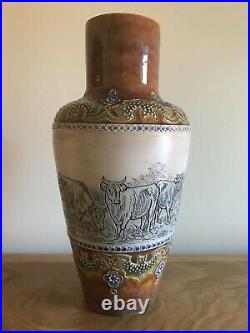Posted on September 23, 2023
Fabulous 1907 Doulton Lambeth Hannah Barlow Highland Cattle Stoneware Vase













Here for your consideration is an exquisite and extremely rare, antique, Edwardian, handmade 1907, Doulton Lambeth, stoneware, 10 shouldered baluster vase, showing incised decoration of highland cattle, with applied and tube tool decoration, painted with pigments, complete with an aesthetic floral foliage and strapwork pattern, applied sgraffito. The vase is decorated with seven carved and etched highland cattle. A beautiful and extremely rare, shouldered, baluster vase, distinctive and attractive in appearance, set in a Renaissance style, that was made by Hannah Bolton Barlow in 1907. It has stunning dark tones of brown, fawn, grey, cream and blue with the usual factory signed identification marks, impressed to its base. England being added in 1891. Condition: no chips, cracks, hairlines, restoration or damage. It does have some age-related base wear, commensurate with 111 years of age, but nothing unusual. Please take time to look at all 12 photos to fully appreciate the workmanship in this delightful vase. The Royal Doulton Company began as a partnership between John Doulton, Martha Jones, and John Watts, with a factory at Vauxhall Walk, Lambeth, London. Their business specialised in making stoneware items. The company took the name Doulton in 1853. By 1871, Henry Doulton, John’s son, launched a studio at the Lambeth Pottery and offered work to designers and artists from the nearby Lambeth School of Art. The first to be engaged was George Tinworth followed by artists such as the Barlow family (Florence, Hannah, and Arthur), Frank Butler, Mark Marshall and Eliza Simmance. The headquarters building and factory of the Royal Doulton ceramics firm were in Lambeth, on the south bank of the Thames. This Art Deco building was designed by T. In 1939 Gilbert Bayes created the friezes that showed the history of pottery through the ages. The Lambeth factory closed in 1956 due to clean air regulations preventing the urban production of salt glaze. Following closure, work was transferred to the Potteries. The factory building was demolished in 1978 and the friezes transferred to the Victoria & Albert Museum. The office building in Black Prince Road still survives, complete with a frieze of potters and Sir Henry Doulton over the original main entrance, executed by George Tinworth. On 30 September 2005, the Nile Street factory closed. Some items are now made in the parent company, WWRD Holdings Ltd in Barlaston, Staffordshire. Further production is carried out in Indonesia. Royal Doulton Ltd finally went into administration on 5 January 2009. An artist who painted pottery for Doulton Lambeth. Her parents were bank manager Benjamin Barlow and his wife Hannah. They had seven siblings, three of whom also worked for Doulton, Florence, Arthur and Lucy who worked in the lesser role of a relief border decorator. Hannah, after studying at the Lambeth School of Art, started working for Doulton from 1871, becoming the first female artist to work there. Florence followed in 1873. By mutual agreement, Florence specialised in painting flowers and birds, and Hannah in horses and other animals, sometimes working together on individual pieces. Hannah died on 15 November 1916 in Clapham, London. Her sketchbooks are in the Sir Henry Doulton Gallery, Stoke-on-Trent. Hannah Barlow is, without doubt, one of the most iconic artists ever to have worked for Doulton Lambeth, her ceramic pieces are collected, admired, and revered the world over! Dimensions as follows. Height: 10.75 inches or 27.3 cm. Diameter: 2.75 inches or 7 cm (top). Diameter: 3.15 inches or 8 cm (base). Weight: 2 lb 11 oz or 1.24 kg. This delightful vase is an extremely rare find indeed. I’ve only got one and once it’s gone…. You might never find another vase this good and if there’s one thing I’ve learned about antiques and collectables when items are of quality and extremely rare he who hesitates usually loses out. A rare vase that would add value to any Doulton Lambeth collection. A real must for any serious collector. Doulton Lambeth, Hannah Barlow vases that have become so very sought-after/collectable and are appreciating in value, basically because people are beginning to realise, the skill and workmanship involved in creating these exquisite vases! This magnificent, Doulton Lambeth highland cattle vase, would make an ideal gift. Please note all my international postal charges are only estimates and will be confirmed and altered up or down when I know the destination of where items are being sent. Please feel free to look at my other items.

